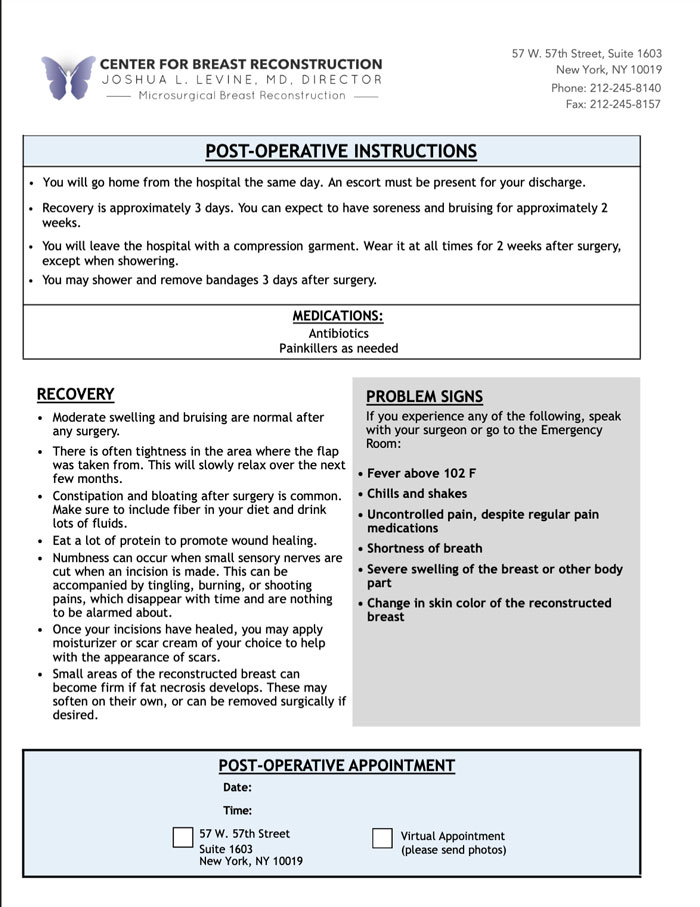Postoperative (After Surgery) Guide
Our post-operative guide offers invaluable support with instructions for the immediate period after surgery, wound care protocols, medication guidance, recommendations for safe physical activity, and recovery instructions to facilitate a successful and comfortable healing process.
Post-surgery healing after breast reconstruction requires careful attention to recovery, self-care, and emotional well-being, ensuring the best possible results and overall quality of life.
Table of Contents
- 1Post-Operative Care and Instructions
- 2Medications
- 3
Recovery
- 4
Wound Care
- 5
Activity
- 6Problem Signs

2. Medications
• Antibiotics
• Painkillers as needed
• Take the antibiotic prescribed until completely gone
• Your prescribed pain medicine should be used on an as needed basis. As soon as you are comfortable doing so switch to extra-strength Tylenol or Ibuprofen, as narcotics may be causing nauseating and/or constipation
• We recommend taking over the counter aids such as senekot-S or Colace while recovering from surgery to maintain bowel regularity
• DO NOT drive until you have stopped all pain medications. For most driving is OK 2 weeks after surgery
3. Recovery
Swelling:
• Moderate swelling and bruising are normal after any surgery.
Tightness:
• There is often tightness in the area where the flap was taken from. This will slowly relax over the next few months.
Constipation / Bloating:
• Constipation and bloating after surgery is common. Make sure to include fiber in your diet and drink lots of fluids.
Protein for Wound Healing:
• Eat a lot of protein to promote wound healing.
Numbness, Tingling, Burning:
• Numbness can occur when small sensory nerves are cut when an incision is made. This can be accompanied by tingling, burning, or shooting pains, which disappear with time and are nothing to be alarmed about.
Timing for Moisturizer / Scar Cream:
• Once your incisions have healed, you may apply moisturizer or scar cream of your choice to help with the appearance of scars.
Fat Necrosis:
• Small areas of the reconstructed breast can become firm if fat necrosis develops. These may soften on their own, or can be removed surgically if desired.
4. Wound Care
• Empty and record drain output 3 times daily on the sheet provided for you
• Dressings may be changed daily if present prior to discharge. Gauze and tape is removed and suture lines cleansed lightly with hydrogen peroxide prior to placement of fresh gauze and tape
• Only sponge bathing is allowed until all the drains have been removed
• Do not soak in tub for at least 2 weeks after surgery and pat the skin dry afterwards
5. Activity
• Do not wear a bra for 3 weeks after discharge
• No driving for 2 weeks
• No sexual activity for at least 3 weeks
• No SMOKING
• No lifting of objects >5 lbs. for 3 weeks
• Daily walks are recommended
• Do no sleep on your side or abdomen for 3 weeks
• Flying or traveling as a passenger is OK after the first week
6. Problem Signs
If you experience any of the following, speak with your surgeon or go to the Emergency Room:
• Fever above 102 F
• Chills and shakes
• Uncontrolled pain, despite regular pain medications
• Shortness of breath
• Severe swelling of the breast or other body part
• Change in skin color of the reconstructed breast

